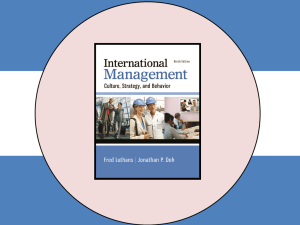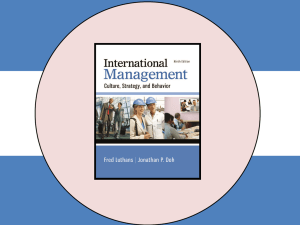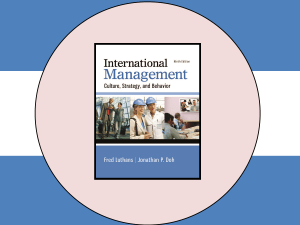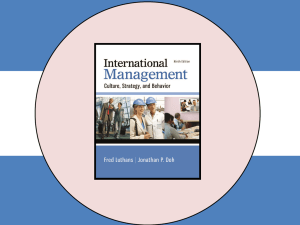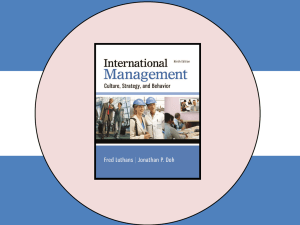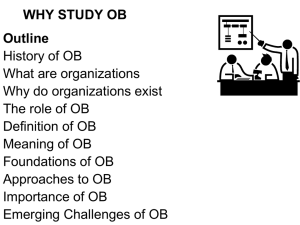Chapter 8
advertisement
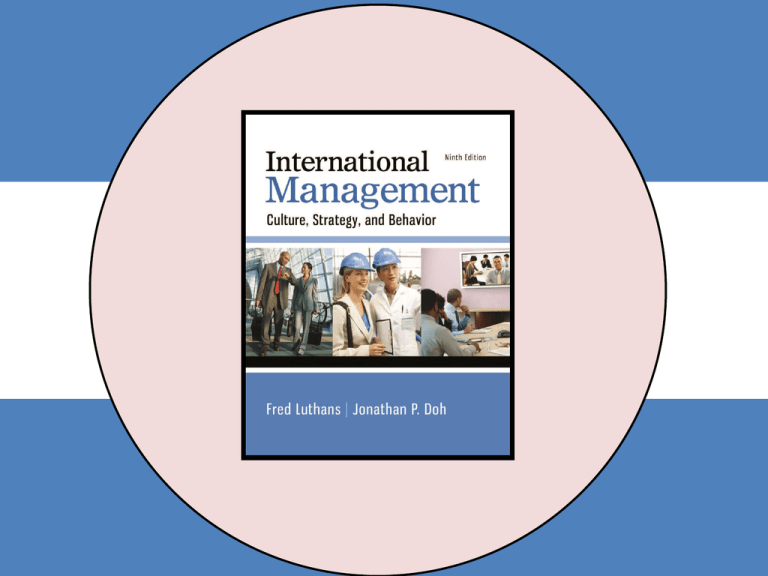
International Management International Ninth Edition Management Luthans | Doh Fred Luthans Jonathan P. Doh Ninth Edition Chapter 8 Strategy Formulation and Implementation International Management Ninth Edition Luthans | Doh Strategy Formulation and Implementation • The specific objectives of this chapter are to 1. 2. 3. 4. 5. 6. DISCUSS the meaning, needs, benefits, and approaches of the strategic planning process for today’s MNCs. UNDERSTAND the tension between pressures for global integration and national responsiveness and the four basic options for international strategy. IDENTIFY the basic steps in strategic planning, including environmental scanning, internal resource analysis of the MNC’s strengths and weaknesses, and goal formulation. DESCRIBE how an MNC implements the strategic plan, such as how it chooses a site for overseas operations. REVIEW the three major functions of marketing, production, and finance that are used in implementing a strategic plan. EXPLAIN specialized strategies appropriate for emerging markets and international new ventures. International Management Ninth Edition Luthans | Doh Strategic Management • Strategic Management – The process of determining an organization’s basic mission and long-term objectives and then implementing a plan of action for pursuing the mission and attaining these objectives. • Corporations need strategic management in order to keep track of their increasingly diversified operations in a continuously changing international environment. International Management Ninth Edition Luthans | Doh Benefits of Strategic Planning • According to one study, 70 percent of 56 U.S. MNC subsidiaries in Asia and Latin America had comprehensive 5- to 10-year plans. • Evidence for effectiveness of planning is mixed. – Strategic planning does not always result in higher profitability. – The specifics of the situation will dictate the success of the process. International Management Ninth Edition Approaches to Formulating and Implementing Strategy 1. 2. 3. 4. Economic Imperative Political Imperative Quality Imperative Administrative Coordination Luthans | Doh International Management Ninth Edition Luthans | Doh Approaches to Formulating and Implementing Strategy Economic Imperative • Economic imperative – Worldwide strategy based on cost leadership, differentiation, and segmentation • Often products sold by MNCs have a large portion of value added in upstream activities of the industry’s value chain. – Research and development – Manufacturing – Distribution • Strategy is also used when the product is regarded as generic and therefore does not have to be sold based on name brand or support service. International Management Ninth Edition Luthans | Doh Approaches to Formulating and Implementing Strategy Political Imperative • Political imperative – Strategy formulation and implementation utilizing strategies that are country-responsive and designed to protect local market niches. • Success of product or service depends on: – Marketing – Sales – Service • These MNCs often use country-centered or multidomestic strategy. International Management Ninth Edition Luthans | Doh Approaches to Formulating and Implementing Strategy Quality Imperative • Quality imperative • Takes two interdependent paths: 1. A change in attitudes and a raising of expectations for service quality 2. The implementation of management practices designed to make quality improvement an ongoing process. • TQM Total Quality Management International Management Ninth Edition Luthans | Doh Total Quality Management • TQM – Cross-train personnel to do jobs of all members in work group – Process re-engineering designed to help identify/eliminate redundant tasks and wasteful effort – Reward system designed to reinforce quality performance • TQM can be summarized: – Quality is operationalized by meeting or exceeding customer expectations. – Quality strategy is formulated at top management level and diffused throughout the organization. – TQM techniques: traditional inspection and statistical quality control; cutting edge Human Resource Management techniques, such as self-managing teams and empowerment International Management Ninth Edition Luthans | Doh Approaches to Formulating and Implementing Strategy • Administrative Coordination – MNC makes strategic decisions based on the merits of the individual situation rather than using a predetermined economic or political strategy. – Used when rapid, flexible decision making is needed to close the sale • Least common approach to formulation and implementation of strategy • Many large MNCs work to combine all four of the approaches to strategic planning. International Management Ninth Edition Luthans | Doh Global and Regional Strategies • Fundamental Tension: The globalization vs. national (or regional or local) responsiveness conflict • Global integration – Production and distribution of products and services of a homogenous type and quality on a worldwide basis • National responsiveness – The need to understand different consumer tastes in segmented regional markets and respond to different national standards and regulations imposed by autonomous governments and agencies International Management Ninth Edition Luthans | Doh Global Integration vs. National Responsiveness International Management Ninth Edition Luthans | Doh Summary and Implications of the Four Basic Strategies • Appropriateness of each strategy depends on pressures for cost reduction and local responsiveness in each country served – International strategy make use of valuable core competencies that host-country competitors lack. – Multi-domestic strategy is useful with high pressure for local responsiveness and low pressures for cost reductions. – Global strategy is a low-cost strategy when attempting to benefit from scale economies in production, distribution, marketing. – Transnational strategy is pursued when there are high cost pressures and high demand for local responsiveness. International Management Ninth Edition Luthans | Doh Basic Elements of Strategic Planning for International Management International Management Ninth Edition Luthans | Doh Environmental Factors Affecting Organizations International Management Ninth Edition Luthans | Doh Elements of Strategic Planning Environmental Scanning • Environmental scanning – Provides management with accurate forecasts of trends relating to external changes in geographic areas where the firm is doing business or considering doing business. • Changes relate to environment factors that can affect the company – – – – – – Industry or market Technology Regulations Economic aspects Social aspects Political aspects International Management Ninth Edition Luthans | Doh Elements of Strategic Planning Internal Resource Analysis • Internal resource analysis is used to evaluate MNC’s current managerial, technical, material, and financial resources and capabilities to assess its strengths and weaknesses. – Assessment then used to determine ability to take advantage of international market opportunities – Match external opportunities (gained in environmental scan) with internal capabilities (gained through internal resource analysis) – Key question for MNC: Do we have the people and resources that can help us to develop and sustain the necessary Key Success Factors (KSF), or can we acquire them? International Management Ninth Edition Luthans | Doh Elements of Strategic Planning Strategic Planning Goals • Goal formulation often precedes first two steps (environmental scanning, internal analysis). • More specific goals for strategic plan come from external scanning and internal analysis. – Goals serve as an umbrella beneath which subsidiaries and other international groups operate. – Profitability and marketing goals almost always dominate strategic plans. – Once strategic goals are set, the MNC develops specific operational goals and controls, usually through a 2-way process at the subsidiary or affiliate level. International Management Ninth Edition Luthans | Doh Areas for Formulation of MNC Goals International Management Ninth Edition Luthans | Doh Strategy Implementation • Strategy Implementation – Provides goods and services in accord with plan of action – Plan often will have overall philosophy or guidelines that direct the process. • Considerations in selecting country – Advanced industrialized countries offer largest markets for goods/services – Amount of government control – Restrictions on foreign investment – Specific benefits offered by host countries International Management Ninth Edition Luthans | Doh Strategy Implementation Location Considerations • Two primary considerations 1. The country 2. The specific locale within the chosen country • The Country – Traditionally MNCs invest in highly industrialized countries that offer the largest markets for goods and services. • Developing countries like Mexico are becoming more attractive. – The amount of government control and restrictions is a factor. – Specific benefits offered by host countries include low tax rates, low/no interest loans, subsidies, but this trend is changing. International Management Ninth Edition Luthans | Doh Strategy Implementation Location Considerations • Local Issues – Once the country has been selected, the firm must choose a specific locale. – Important factors that influence this choice • • • • Access to markets Proximity to competitors Availability of transportation and electric power Desirability of location for employees coming in from outside International Management Ninth Edition Luthans | Doh Strategy Implementation Location Considerations • Frontier Markets – Also called pre-emerging markets; a unique subset of emerging economies – Less correlated to ups and downs of global economy – Offer potentially high rewards, but with high risk – Often located in Africa and Asia – Potential strategy: joint venture with a local company with cultural knowledge of the market International Management Ninth Edition Luthans | Doh Strategy Implementation The Role of the Functional Areas • Marketing – What works in one market may not work in another – Marketing may be dictated by the overall strategic plan – Marketing strategy involves the four “Ps” • • • • Product Price Promotion Place International Management Ninth Edition Luthans | Doh Strategy Implementation The Role of the Functional Areas • Production – When exporting goods to foreign markets, production has usually been handled through domestic operations. – More recently MNCs have found that whether they export or produce goods locally in the host country, consideration of worldwide production is important. – Recent trend has been away from a multi-domestic approach and toward a global coordination of operations. – If product labor-intensive, the trend is to farm out the product to low-cost sites (e.g., Mexico). International Management Ninth Edition Luthans | Doh Strategy Implementation The Role of the Functional Areas • Finance – Transferring funds from one place in the world to another, or borrowing funds in international money markets, is often less expensive than relying on local sources. – Issues include • Reevaluation of currencies • Volatile monetary exchange rates International Management Ninth Edition Luthans | Doh Specialized Strategies • Some circumstances may require specialized strategies: – Strategies for developing and emerging markets – Strategies for international entrepreneurship and new ventures International Management Ninth Edition Luthans | Doh Specialized Strategies Strategies for Emerging Markets • Emerging markets will compose more than half of global economic output by midcentury. – “BRIC” economies: Brazil, Russia, India, and China • Emerging markets present exceptional risks due to political and economic volatility. These risks show up in: – – – – Corruption Failure to enforce contracts Red tape and bureaucratic costs General uncertainty in legal and political environment International Management Ninth Edition Luthans | Doh Specialized Strategies Strategies for Emerging Markets • First Mover Strategies – Significant economies associated with early entry include learning effects, scale economies, opportunities for developing alliances, and advantages over competitors. – There may be a narrow window of opportunity within which these opportunities can be best exploited. International Management Ninth Edition Luthans | Doh Specialized Strategies Strategies for Emerging Markets • Strategies for Base of Pyramid (BOP) – 5+ billion potential customers around the globe heretofore have been ignored by global business. • BOP forces global business to rethink their strategies. – Must consider relationships with local governments, small entrepreneurs, and nonprofits rather than depend on established partners such as central governments and large local companies • BOP strategies are challenging to implement • Represents opportunity to incubate new, leapfrog technologies • Successful BOP strategies can travel profitably to higher income markets • Marketing at BOP forces consideration of smaller-scale strategies International Management Ninth Edition Luthans | Doh The World Population and Income Pyramid International Management Ninth Edition Luthans | Doh Specialized Strategies Entrepreneurship Strategy and New Ventures • Increasingly small and medium size enterprises, often in the form of new ventures, are becoming involved in international management. • The earlier in its existence an innovative firm internationalizes, the faster it is likely to grow both overall and in foreign markets. • Venture performance (growth and ROE) is improved by technological learning gained from international environments. International Management Ninth Edition Luthans | Doh Specialized Strategies International Entrepreneurship • International Entrepreneurship – A combination of innovative, proactive, and riskseeking behavior that crosses national borders and is intended to create value in organizations. International Management Ninth Edition Luthans | Doh Specialized Strategies International New Ventures and “Born Global” Firms • International New Ventures or Born-Global Firms – Firms that engage in significant international activity a short time after being established – Successful born-global firms leverage a distinctive mix of orientations and strategies: • • • • Global technological competence Unique product development Quality focus Leveraging of foreign distributor competencies – Truly born-global firms tend to survive longer than other seemingly global companies. International Management Ninth Edition Luthans | Doh Review and Discuss 1. Of the four imperatives discussed in this chapter— economic, political, quality, and administration— which would be most important to IBM in its efforts to make inroads in the Pacific Rim market? Would this emphasis be the same as that in the United States, or would IBM be giving primary attention to one of the other imperatives? Explain. 2. Define global integration as used in the context of strategic international management. In what way might globalization be a problem for a successful national organization that is intent on going international? In your answer, provide an example of the problem. International Management Ninth Edition Luthans | Doh Review and Discuss 3. Some international management experts contend that globalization and national responsiveness are diametrically opposed forces, and that to accommodate one, a multinational must relax its efforts in the other. In what way is this an accurate statement? In what way is it incomplete or inaccurate? 4. Consider that both a retail chain and a manufacturing company want to expand overseas. What environmental factors would have the most impact on these companies? What ratio of environmental scanning to internal analysis should each employ? What key factors of success differentiate the two? International Management Ninth Edition Luthans | Doh Review and Discuss 5. Anheuser-Busch is attempting to expand in India, where beer is not widely consumed and liquor dominates the market. What areas should be targeted for strategic goals? What could be some marketing implications in the Indian market? 6. What particular conditions that MNCs face in emerging markets may require specialized strategies? What strategies might be most appropriate in response? How might a company identify opportunities at the “base of the pyramid” (i.e., lowincome markets)? International Management Ninth Edition Luthans | Doh Review and Discuss 7. What conditions have allowed some firms to be born global? What are some examples of bornglobal companies? 8. Mercedes changed its U.S. strategy by announcing that it is developing cars for the $30,000 to $45,000 price range (as well as its typical upper-end cars). What might have accounted for this change in strategy? In your answer, include a discussion of the implications from the standpoints of marketing, production, and finance.




